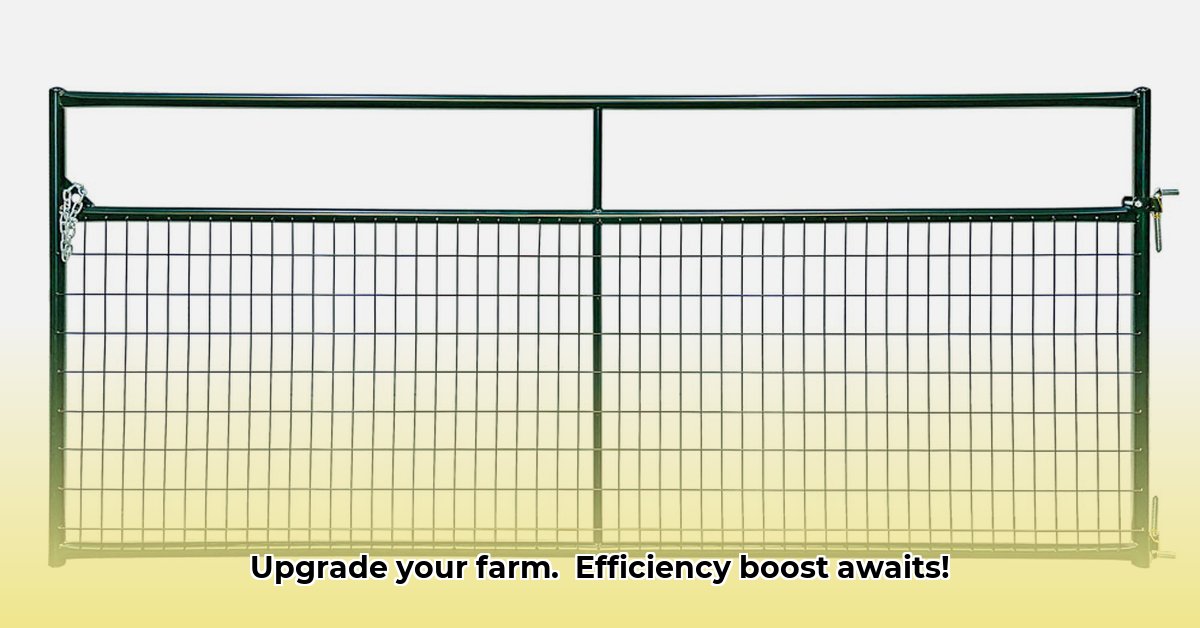
10 Foot Gate Tractor Supply: Boosting Farm Efficiency
Farm gates: often overlooked, yet critical to efficient farm operations. Upgrading to a reliable 10-foot gate from Tractor Supply can significantly improve your workflow. This seemingly small change can yield substantial benefits in daily farm management. For smaller gates, check out these options: 6ft gate options. But how do you choose the right gate for your needs? Let's delve in.
Finding the Right Fit: Why a 10-Foot Gate?
Gate size is crucial. A 10-foot gate provides a good balance for many farms, allowing easy passage for most equipment and preventing frustrating bottlenecks. However, your specific needs dictate the ideal size. Do you regularly move large machinery or wide trailers? Accurate measurements are essential before purchasing. Don't underestimate the importance of future-proofing—will your operation expand in the future, requiring a larger gate?
Material Matters: Selecting the Best Gate for Your Farm
Gate materials directly influence lifespan and maintenance needs. Tractor Supply offers various options: steel, wood, and vinyl/PVC. Each presents unique advantages and disadvantages:
| Material | Advantages | Disadvantages |
|---|---|---|
| Steel | Durable, long-lasting, strong | Prone to rust; requires regular maintenance |
| Wood | Relatively inexpensive, aesthetically pleasing | Requires frequent maintenance; susceptibility to rot and warping |
| Vinyl/PVC | Low-maintenance, weather-resistant | Typically more expensive; may lack the strength of steel |
Climate and budget significantly influence material choice. High humidity favors rust-resistant materials like galvanized steel. Wood might be more suitable in drier regions. Consider frequency of use and the size of equipment passing through the gate. Heavy-duty steel is ideal for frequent use and large machinery; wood may suffice for less demanding situations. Isn't choosing the right material about ensuring long-term cost savings and minimizing hassle?
Installation: A Straightforward Process (Most of the Time)
Installing a 10-foot gate is often a manageable DIY project with basic carpentry skills. However, for larger or complex installations, professional assistance is recommended.
Steps for Gate Installation:
- Prepare Gateposts: Securely set gateposts in concrete for maximum stability. This foundation is crucial; dig deep, use ample concrete, and allow for proper curing.
- Hang the Gate: Carefully attach hinges, ensuring smooth opening and closing. Use appropriate hardware for your chosen gate material. Improper hardware leads to premature wear.
- Secure the Latch: Install a durable latch and locking mechanism; ease of use and security are both essential.
- Fine-Tune Alignment: Meticulously check alignment. Misalignment can cause damage over time. Make necessary adjustments to ensure everything is perfectly straight.
Always refer to the gate's specific installation instructions. Prioritize safety; wear appropriate gear, and seek professional help if unsure.
Beyond the Gate: Smart Farming Integration
Smart farming is increasingly prevalent, and your gate should integrate seamlessly. Automated opening and closing systems, controllable remotely, boost efficiency. Smart sensors track gate activity, providing valuable data on livestock movement and equipment usage. This data can optimize your operations. Don't your operations deserve the efficiency gains of smart technology?
The Big Picture: Improved Efficiency and Cost Savings
Investing in a high-quality 10-foot gate is an investment in productivity and cost reduction. It reduces time and effort spent opening and closing the gate, potentially saving considerable time and money. It enhances animal welfare by minimizing stress and prevents escapes. A durable, functioning gate contributes to a smooth, productive work environment.
How to Choose Sustainable Farm Gate Materials for Long-Term Cost Savings
Choosing durable materials minimizes replacements, saving money. Sustainable materials reduce environmental impact. Proper gate design improves farm efficiency and animal welfare. Quality gates enhance farm security. Future-proofing ensures compatibility with smart farming technologies.
Why Upgrade Your Farm Gates? It's More Than Just a Gate
Farm gates control the flow of everything. A poorly built gate creates bottlenecks and inefficiencies. Upgrading to a high-quality, sustainable gate is a valuable investment.
How to Choose Sustainable Farm Gate Materials for Long-Term Cost Savings: A Practical Guide
Material selection is crucial for longevity and cost-effectiveness:
- Wood: Requires regular maintenance (pressure-treated lumber essential; consider sustainably sourced wood). While initially inexpensive, long-term maintenance costs can offset savings.
- Metal: Steel, aluminum, and galvanized steel are highly durable but vary in maintenance needs and strength. Recycled metal is a sustainable choice.
- Composite Materials: Combine the benefits of wood and metal; often more expensive upfront. Consider recycled content.
Choosing the right gate type (swing, sliding, or automated) depends on your specific needs and space constraints.
Long-Term Cost Savings: The Bigger Picture
A high-quality gate may cost more upfront, but its longer lifespan reduces replacement costs and maintenance expenses. Factor in potential losses due to gate failure. A durable gate is a long-term investment in minimizing costs.
Integrating Sustainability into Your Gate Choice
Sustainability involves: sourcing materials responsibly, maximizing durability, minimizing maintenance, and extending the gate's lifespan.
Step-by-Step Gate Selection: A Practical Approach
- Assess Needs: Consider farm layout, traffic patterns, livestock size, machinery access, and security.
- Budgeting: Balance long-term costs and upfront investment.
- Material Selection: Prioritize durability, maintenance, and sustainability.
- Supplier Research: Compare quality, pricing, and installation services.
- Installation: Professional installation ensures longevity and safety.
- Maintenance Plan: Develop a plan to maximize gate lifespan.